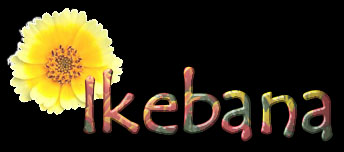 |
|
|
|
|
|
|
"Through
the act of arranging flowers one can realize Gods’ blessing that
Senei Ikenobo, March 1962 The Japanese art of flower arranging known as Ikebana is steeped in tradition, spirituality, a love of simplicity and the beauty of the universe. Its cultural beginnings as ‘kuge’ and ‘shogan’ - floral offerings and ornaments to Buddha - began in the 6th century when Buddhism came to Japan. It later assumed a role in the ‘mitsugusoku’ of Buddhist practice – the trio of incense burner flanked by a candlestick and vase of flowers, placed on the oshi-ita (alcove). Through time it has played an integral role in Chanoyu (tea ceremony) and Kodo (incense burning), and similarly as decoration in the Japanese home. From its early practice, chiefly by doboshus (priests and retainers to the shogun), responsibility for the art shifted to priests around the early 15th century. By the 17th century the priests of the Ikenobo school based at the Rokkakudo Temple in Kyoto had become the recognized masters. A number of schools and respective styles have developed over the centuries, each with its own philosophy, and these are followed both strictly and liberally (depending on the school) to this day. The three main schools are Ikenobo, Ohara and Sogetsu, however there are over 2,000 registered schools in Japan today. It is now an art form practiced and taught throughout the world. The Japanese believe Ikebana speaks directly to the heart of the creator and the viewer. It is sculpture that breathes and expresses stability and the spirit of Nature, a link to the whole universe. The positive (yoh) and negative (in) energy, and the harmony therein, represent the energies of life and death and the passing of time - past, present and future. The flower bud contains, for instance, the energy force of life towards the future. There are generally three principal parts to the Ikebana arrangement: ‘shin’ - the main stem representing man (yoh); ‘soe’ - representing heaven (yoh); and ‘tai’ - representing earth (in). Great care is taken in the choice of materials, and their preparation and presentation. The whole experience is one of contemplation, discipline, observation and respect – quite spiritual. The creator becomes quiet, exists simply "in the moment", totally focussed on the task at hand. Combinations of colour, lines, negative space, and harmony between shapes are all considered in minute detail. And this attention extends from the organic materials of the arrangement to the container and the setting. Attention to the selection of materials is of such great significance, for instance, that it formed the subject of a famous ‘kyogen’ (comic play) titled "Shin’ubai." In the play a daimyo (feudal lord) traveled to Higashiyama in Kyoto in search of a branch suitable for the shin (main stem) for a rikka arrangement. Such devotion! Ikebana is in many respects seasonal; it depends on the availability of various organic materials, plus certain arrangements are favored for seasons and festive occasions. For instance, a summer arrangement may evoke ‘coolness’ – materials in season may be complemented by cool colours, water-side plants and a simple uncluttered style. And different materials symbolise different aspects of nature – bamboo, for instance, represents integrity as it does not bend. The country of origin also plays a significant role in choices – now that Ikebana is practiced world-wide a host of native plants are available to arrangers. Depending on the traditions of the school, arrangements may include branches, leaves, flowers, buds, wildflowers, roots, seedpods, moss, or fruit. Contemporary Ikebana extends the tradition to include more varied materials such as vegetables, tree trunks, tatami mats and other organic materials (and sometimes even inorganic materials). Containers may include shallow broad vases, tall elegant vases, bamboo, baskets, water trays, or in modern arrangements almost anything. In fact, contemporary Ikebana can take the form of installations without the restrictions of containers. Robyn
|
|
||
|
|
 |
|
Legals: Copyrights are maintained by respective contributors and may not be reused without permission. Graphics and scripts may not be directly linked to. Site assets copyright © 1999 - 2003 by RamaLila. Photo of Dr. Frederick Lenz (Rama) reprinted with permission. By using this site, you agree to relinquish all liabilities and claims financial or otherwise against RamaLila and its contributors. Visit this site at your own risk. |
